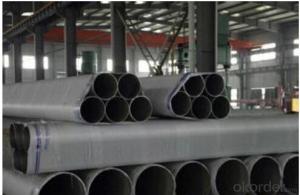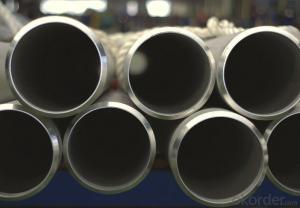Stainless Steel Seamless Pipe 316 ASTM A312
- Loading Port:
- Ningbo
- Payment Terms:
- TT OR LC
- Min Order Qty:
- 1 m.t.
- Supply Capability:
- 5000 m.t./month
OKorder Service Pledge
OKorder Financial Service
You Might Also Like
1、Structure of Stainless Steel Seamless Pipe 316 ASTM A312 Description:
Stainless seamless pipe is formed by drawing a solid billet over a piercing rod to create the hollow shell. As the manufacturing process does not include any welding, seamless pipes are perceived to be stronger and more reliable. Historically seamless pipe was regarded as withstanding pressure better than other types, and was often more easily available than welded pipe.
2、Main Features of the Stainless Steel Seamless Pipe 316 ASTM A312:
• High manufacturing accuracy
• High strength
• Small inertia resistance
• Good visual effect
•Reasonable price
3、Stainless Steel Seamless Pipe 316 ASTM A312 Images:
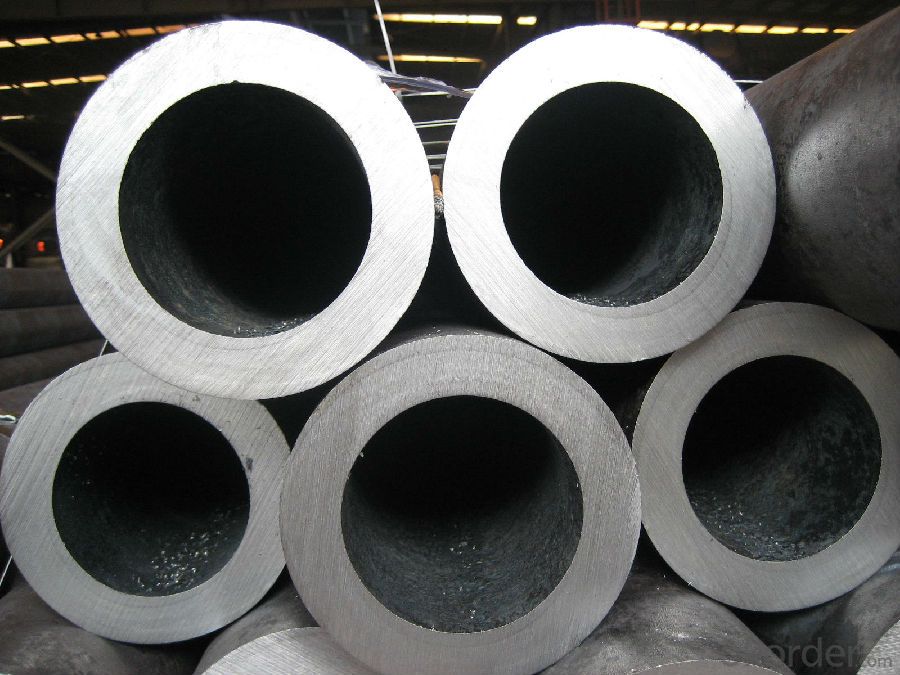
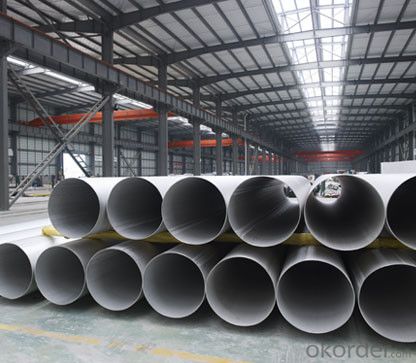
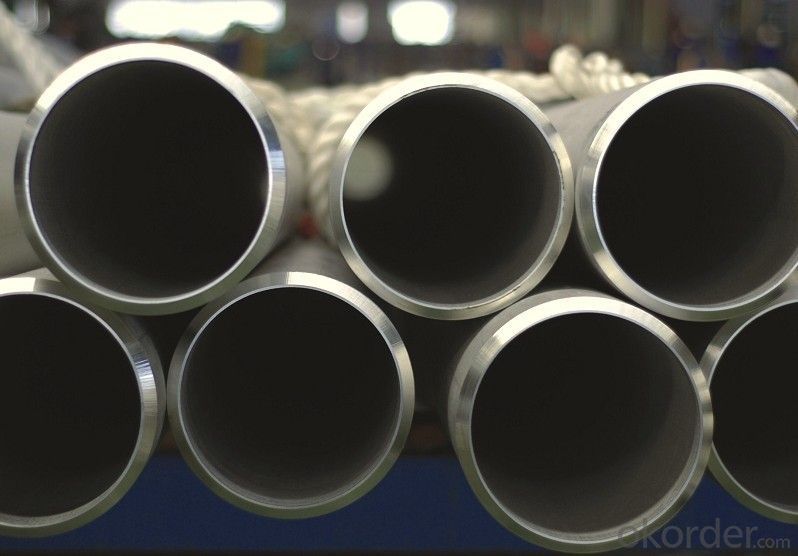
4、Stainless Steel Seamless Pipe 316 ASTM A312 Specification:
| Standard | ASTM A213/A213M-06,ASTM A312/A312M-06, ASTM A376/A376M-06,ASTM A789/A789M-05b, ASTM A790/A790M-05b,ASTM A268/A268M-05a, ASTM A269 |
GB/T 13296-2007,GB/T 14976-2002 | |
| JIS G3459-2004,JIS G3163-2006,JIS G3467-1988 | |
| Material : | 201,202 ,304,304L,304N,304LN,301,305,309S,310S,316,316L,316N,316LN,316Ti 317,317L,321,347, 321h,347,904L,2205,S31803, |
| Dimension: | 5*5mm~150*150mm |
| Thickness : | 0.4mm~80mm |
| Length : | 3m,4m,5.8m,6m,12m or as required |
| Surface : | Annealing ,polish,pickling,bright ,sand blast ,etc |
| Packing: | Standard export seaworthy package or as customer's demand |
| Application: | petroleum ,chemical industry,bolier ,heat exchange,high temperature resistant transmission, fluid pipe in power station,ship with pressure pipe,construction and so on. |
| Delivery: | prompt delivery |
| Quality control: | Mill Test Certificate is supplied with shipment.Third Part Inspection is also acceptable |
5、FAQ of Stainless Steel Seamless Pipe 316 ASTM A312:
①How is the quality of your products?
Our products are manufactured strictly according to national and internaional standard, and we take a test
on every pipe before delivered out. If you want see our quality certifications and all kinds of testing report, please just ask us for it.
Guaranteed: If products’ quality don’t accord to discription as we give or the promise before you place order, we promise 100% refund.
②How about price?
Yes, we are factory and be able to give you lowest price below market one, and we have a policy that “ for saving time and absolutely honest business attitude, we quote as lowest as possible for any customer, and discount can be given according to quantity”,if you like bargain and factory price is not low enough as you think, just don’t waste your time.Please trust the quotation we would give you, it is professional one.
③Why should you chose us?
Chose happens because of quality, then price, We can give you both.Additionally, we can also offer professional products inquiry, products knowledge train(for agents), smooth goods delivery, exellent customer solution proposals.Our service formula: good quality+good price+good service=customer’s trust
SGS test is available, customer inspection before shipping is welcome, third party inspection is no problem.
Any question, pls feel free to contact us !
- Q:Can stainless steel pipes be etched?
- Yes, stainless steel pipes can be etched. Etching is a process of removing a thin layer of metal from the surface of the pipe to create a desired design or pattern. This is typically done using an acid or chemical solution that selectively dissolves the exposed metal. However, it is important to note that not all grades of stainless steel are equally suitable for etching. Austenitic stainless steels, such as 304 and 316, are commonly used for etching due to their corrosion resistance and ease of etching. Other factors that can influence the etching process include the composition and thickness of the stainless steel, as well as the etching method and conditions used.
- Q:Can stainless steel pipes be used for chemical pumps?
- Indeed, chemical pumps can utilize stainless steel pipes. Renowned for its corrosion resistance, stainless steel proves to be an appropriate substance for managing diverse chemicals. Its ability to endure the corrosive properties of numerous chemicals safeguards against contamination of the fluids being pumped. Furthermore, stainless steel pipes provide commendable mechanical strength and endurance, rendering them suitable for chemical pumps that necessitate reliability and sustained effectiveness. Nonetheless, it is crucial to take into account the precise demands of the chemicals being pumped and seek guidance from specialists or manufacturers to guarantee the compatibility of the chosen stainless steel with the specific chemicals and operational circumstances.
- Q:How do you join stainless steel pipes together?
- When it comes to joining stainless steel pipes together, one has various methods to choose from based on their specific requirements and application. The most commonly used and widely preferred method is welding. This involves the application of heat to melt the material, resulting in a strong and durable bond. Different welding techniques, including TIG (Tungsten Inert Gas) or MIG (Metal Inert Gas) welding, can be employed for this purpose. Compression fittings are another popular choice, particularly in plumbing applications. These fittings consist of a compression nut and a ferrule that are tightened onto the pipe, ensuring a secure and leak-proof connection. In situations where a more robust connection is necessary, such as in high-pressure or high-temperature applications, flanges are utilized. This involves bolting flanges at the ends of two stainless steel pipes, creating a tight and reliable connection. Threaded connections are also an option, where one end of the pipe is threaded, and the other end is fitted with a threaded pipe fitting, such as a union or nipple. This method is often employed for smaller diameter pipes or situations that require frequent disassembly. For temporary or frequently disassembled connections, clamps and couplings are used. These devices clamp around the pipes and are tightened using bolts or other mechanisms, providing a secure connection. Considering the specific requirements, such as pressure, temperature, and corrosion resistance, is crucial when selecting the appropriate method to join stainless steel pipes. Seeking advice from professionals or consulting industry standards and guidelines can ensure a successful and reliable pipe connection.
- Q:Can stainless steel pipes be used in harsh environments?
- Yes, stainless steel pipes can be used in harsh environments. Stainless steel is highly resistant to corrosion, rust, and high temperatures, making it suitable for a variety of challenging conditions such as chemical processing plants, offshore oil rigs, and industrial settings. Its durability and resistance to environmental factors make it a reliable choice for harsh environments.
- Q:What is the difference between 2205 and 316 stainless steel pipes?
- The main difference between 2205 and 316 stainless steel pipes lies in their chemical composition and the resulting properties they exhibit. 2205 stainless steel is a duplex stainless steel, meaning it contains a combination of both austenitic and ferritic stainless steels. This composition provides it with excellent corrosion resistance, high strength, and good weldability. It is specifically designed to withstand highly corrosive environments, making it suitable for applications in the oil and gas industry, chemical processing, and marine environments. On the other hand, 316 stainless steel is an austenitic stainless steel that contains a higher percentage of chromium and nickel compared to 2205. This gives it superior corrosion resistance, especially against chlorides and other aggressive chemicals. It also exhibits good heat resistance and is commonly used in applications such as food processing, pharmaceuticals, and medical equipment. In terms of mechanical properties, 2205 stainless steel typically has higher tensile and yield strength compared to 316 stainless steel. This makes it more suitable for applications where strength and durability are critical factors. However, 316 stainless steel offers better formability and is easier to fabricate. In summary, while both 2205 and 316 stainless steel pipes offer corrosion resistance, the choice between them depends on the specific application requirements. 2205 is preferred for highly corrosive environments and applications requiring high strength, while 316 is commonly used in industries where superior corrosion resistance and good formability are essential.
- Q:What is the corrosion resistance of stainless steel pipes?
- Stainless steel pipes offer excellent corrosion resistance due to the presence of chromium in their composition. Chromium reacts with oxygen in the atmosphere to form a thin, protective layer of chromium oxide on the surface of the pipe. This oxide layer acts as a barrier, preventing further oxidation and corrosion of the underlying metal. Additionally, stainless steel pipes are often alloyed with other elements such as nickel and molybdenum, which further enhance their corrosion resistance. As a result, stainless steel pipes are highly resistant to rust, pitting, and other forms of corrosion, making them suitable for a wide range of applications in various industries, including plumbing, oil and gas, chemical processing, and marine environments.
- Q:Can stainless steel pipes be insulated with polycaprolactone?
- Yes, stainless steel pipes can be insulated with polycaprolactone. Polycaprolactone is a versatile and flexible thermoplastic material that can be used for insulation purposes. It can provide effective thermal insulation to stainless steel pipes and help in reducing heat transfer and preventing condensation.
- Q:Are stainless steel pipes suitable for oil refinery applications?
- Yes, stainless steel pipes are highly suitable for oil refinery applications. They offer excellent resistance to corrosion, high temperatures, and aggressive chemicals commonly found in refineries. Stainless steel pipes also have high strength and durability, making them ideal for transporting and storing various petroleum products.
- Q:Can stainless steel pipes be recycled?
- Yes, stainless steel pipes can be recycled. Stainless steel is a highly recyclable material due to its durability and corrosion resistance. When stainless steel pipes reach the end of their useful life or are no longer needed, they can be collected, processed, and melted down to create new stainless steel products. Recycling stainless steel pipes not only helps conserve natural resources but also reduces energy consumption and emissions associated with mining and manufacturing new materials.
- Q:How do you prevent discoloration in stainless steel pipes?
- To prevent discoloration in stainless steel pipes, there are several measures that can be taken: 1. Proper cleaning: Regularly clean the stainless steel pipes using mild soap or detergent and warm water. Avoid using harsh chemicals or abrasive cleaners that can damage the surface and cause discoloration. 2. Rinse thoroughly: After cleaning, make sure to rinse the pipes thoroughly with clean water to remove any residue or cleaning agents that may cause discoloration. 3. Avoid contact with corrosive substances: Keep stainless steel pipes away from direct contact with corrosive substances such as strong acids, alkaline solutions, or chlorides. These substances can lead to chemical reactions and cause discoloration. 4. Use protective coatings: Applying a protective coating, such as a clear lacquer or a special stainless steel protective spray, can help prevent discoloration by creating a barrier between the metal surface and the environment. 5. Control temperature: Excessive heat can cause discoloration in stainless steel pipes. It is important to control the temperature of the surrounding environment or the fluid passing through the pipes to prevent overheating. 6. Regular maintenance: Perform routine inspections and maintenance to identify any signs of discoloration or damage and address them promptly. This includes checking for leaks, corrosion, or any other factors that may contribute to discoloration. By following these preventive measures, you can significantly reduce the risk of discoloration in stainless steel pipes and maintain their aesthetic appeal and functionality for a longer period.
1. Manufacturer Overview |
|
|---|---|
| Location | |
| Year Established | |
| Annual Output Value | |
| Main Markets | |
| Company Certifications | |
2. Manufacturer Certificates |
|
|---|---|
| a) Certification Name | |
| Range | |
| Reference | |
| Validity Period | |
3. Manufacturer Capability |
|
|---|---|
| a)Trade Capacity | |
| Nearest Port | |
| Export Percentage | |
| No.of Employees in Trade Department | |
| Language Spoken: | |
| b)Factory Information | |
| Factory Size: | |
| No. of Production Lines | |
| Contract Manufacturing | |
| Product Price Range | |
Send your message to us
Stainless Steel Seamless Pipe 316 ASTM A312
- Loading Port:
- Ningbo
- Payment Terms:
- TT OR LC
- Min Order Qty:
- 1 m.t.
- Supply Capability:
- 5000 m.t./month
OKorder Service Pledge
OKorder Financial Service
Similar products
New products
Hot products
Hot Searches
Related keywords
